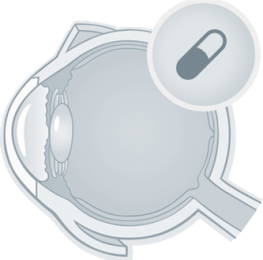SYMPTOMS
Symptoms of neovascular glaucoma depend on the developmental phase of the neovascularization process.
Initially, only small vessels are visible on the surface of the iris, more visible at the confluence with the pupil. It is what is known by the term rubeosis iridis and in this situation, the IOP is still normal.
However, if ischemia persists, eventually the new vessels affect the trabeculae, hampering the exit of the aqueous humour and causing a situation of closed angle secondary glaucoma, resulting in an increase in IOP that can cause progressive loss of visual acuity.
The most serious situation occurs when the vessels cause the total closure of the trabeculae and the angle formed by the iris and the cornea, which completely prevents the circulation of the aqueous humour and results in an important increase of the IOP, in turn producing a secondary closed-angle glaucoma, with very serious symptoms: pain, redness and eye congestion, significant loss of visual acuity, corneal edema and deformation of the pupil.
CAUSES
The formation of these new vessels is due to the fact that blood reaching the retinalacks oxygen (ischemia) and this situation is maintained continuously, which is usually due to long-term or uncontrolled type 2 diabetes, or because the central artery that irrigates the retina is occluded.
However, neovascularization of the iris may have other causes, such as the existence of an ocular tumour, obstruction of the carotid artery due to arteriosclerosis or certain ocular complaints that occur with intraocular inflammation.
TREATMENT
The treatment of neovascular glaucoma depends fundamentally on its stage of development at the time of diagnosis.
In any of the three cases, there will be two objectives: control the IOP and improve the oxygen supply to the retina avoiding the formation of new vessels (neovascularization). In the initial phase (rubeosis iridis), the most commonly used treatment is panretinal photocoagulation, which in most cases will prevent its evolution to secondary glaucoma.
However, if the diagnosis occurs when open-angle or closed-angle glaucoma has already been established, treatment should adjust to this situation by controlling IOP, although it may be necessary to resort to filtration surgery (trabeculectomy) or, in the most severe cases, the implantation of a drainage valve to facilitate the circulation of the aqueous humour.
Antiangiogenic drugs may be used to promote the regression of neovascularization, but generally do not prevent laser photocoagulation and surgical intervention.


SURGERY
The technique of panretinal photocoagulation is performed by the application of a laser in the peripheral retina (always respecting the posterior pole) in order to avoid the formation of new vessels and eliminate those that have already been formed.
RESULTADOS DE LA OPERACIÓN
Como en cualquier otro tipo de glaucoma, el diagnóstico precoz es un factor importante a la hora de establecer el pronóstico y aumentar las posibilidades de éxito del tratamiento.
La técnica de fotocoagulación panretiniana tiene un elevado porcentaje de éxito, permitiendo controlar el proceso de neovascularización y, por tanto la evolución del glaucoma neovascular.


